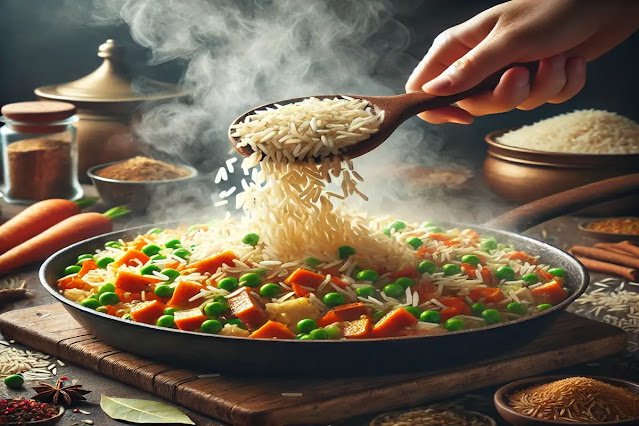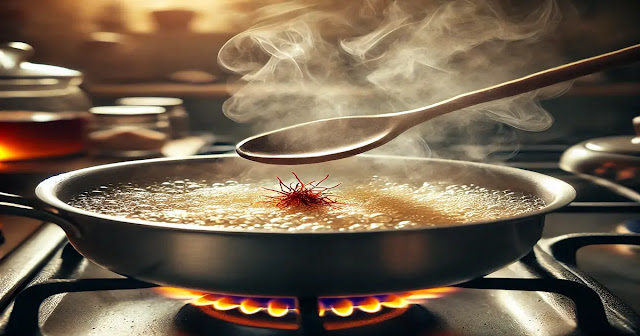Veg Pulao is a delicious, aromatic, and easy-to-make rice dish packed with the flavors of whole spices, basmati rice, and mixed vegetables. It is a one-pot meal that is both light and satisfying, making it a great option for lunch, dinner, or even festive occasions. This dish is naturally gluten-free and can be made vegan by using oil instead of ghee.
Why You’ll Love This Recipe
- Simple and easy to prepare in under 40 minutes.
- Requires minimal ingredients but delivers rich flavors.
- Perfect as a main dish or as a side with dals, curries, or yogurt-based dishes.
- Customizable with your favorite vegetables and seasonings.
Ingredients
For Cooking Rice:
- 1 cup basmati rice (soaked for 20 minutes)
- 2 cups water
- 1 bay leaf
- 1-inch cinnamon stick
- 2 green cardamoms
- 2 cloves
- 1/2 teaspoon salt
For Pulao:
- 2 tablespoons ghee or oil
- 1 teaspoon cumin seeds
- 1 bay leaf
- 1-inch cinnamon stick
- 2 green cardamoms
- 2 cloves
- 1 medium onion, thinly sliced
- 1 teaspoon ginger-garlic paste
- 1 green chili, slit (adjust to spice preference)
- 1/2 cup chopped carrots
- 1/2 cup green peas
- 1/2 cup beans, chopped
- 1/4 teaspoon turmeric powder
- 1/2 teaspoon garam masala
- 1/2 teaspoon coriander powder
- Salt to taste
- 1 tablespoon chopped coriander leaves
- 1 tablespoon fried cashews (optional, for garnish)
Instructions
Step 1: Cooking the Rice
- Wash the basmati rice 2–3 times until the water runs clear. Soak it for 20 minutes and drain before cooking.
- In a pan, boil 2 cups of water. Add a bay leaf, cinnamon, cardamoms, cloves, and salt.
- Add the soaked rice to the boiling water. Cook until the rice is 90% done (it should still have a slight bite).
- Drain the rice and keep it aside. This step prevents the pulao from becoming mushy.
Step 2: Preparing the Pulao Base
- Heat ghee or oil in a heavy-bottomed pan. Add cumin seeds and let them splutter.
- Add bay leaf, cinnamon, cardamoms, and cloves. Sauté for a few seconds until aromatic.
- Add sliced onions and cook until they turn golden brown. This adds depth to the flavor.
- Stir in ginger-garlic paste and green chili. Cook for about a minute until the raw smell disappears.
Step 3: Cooking the Vegetables
- Add chopped carrots, green peas, and beans. Stir-fry for 2-3 minutes on medium heat.
- Sprinkle turmeric, garam masala, coriander powder, and salt. Mix well to coat the vegetables.
- Pour in 2-3 tablespoons of water to help the spices blend into the vegetables. Cover and cook for 3 minutes.
Step 4: Mixing the Rice and Final Touches
- Add the partially cooked rice to the pan.
- Gently mix everything, ensuring that the rice grains do not break.
- Cover with a lid and let the pulao steam on low heat for 5 minutes to absorb all the flavors.
Step 5: Garnishing and Serving
- Turn off the heat and let the pulao rest for a few minutes.
- Garnish with chopped coriander leaves and fried cashews for extra flavor and crunch.
- Serve hot with raita, yogurt, or a side of dal.
Tips & Variations
✅ For extra flavor, add a few strands of saffron soaked in warm milk and drizzle it over the rice before steaming.
✅ To make it richer, toss in some fried paneer cubes or add a handful of golden raisins for a mild sweetness.
✅ For a South Indian twist, add curry leaves and a tablespoon of grated coconut while sautéing the spices.
✅ For a restaurant-style touch, mix in a little coconut milk along with the vegetables for a creamy texture.
✅ For spicy pulao, increase the number of green chilies or add a pinch of red chili powder.
Serving Suggestions
- Serve Veg Pulao hot with a bowl of cucumber raita, boondi raita, or plain yogurt for a refreshing combination.
- Pair it with a dal tadka or paneer curry for a more filling meal.
- Serve alongside papad, pickle, and a salad for a complete, wholesome meal.
Final Thoughts
Veg Pulao is a classic dish that combines the simplicity of rice with the richness of aromatic spices and vegetables. Whether you are making it for a quick weekday meal or a special occasion, it is sure to impress with its flavor and presentation. Try this easy recipe today and enjoy a wholesome, comforting dish!
(FAQ's)
1. What is Veg Pulao?
Veg Pulao is a one-pot rice dish made with basmati rice, mixed vegetables, and whole spices. It is mildly spiced and has a fragrant, rich flavor. It is different from biryani, as it is simpler, lighter, and quicker to prepare.
2. What is the difference between Pulao and Biryani?
- Pulao is a one-pot dish where rice and vegetables are cooked together with mild spices.
- Biryani is layered and slow-cooked, with rice and curry (gravy-based masala) prepared separately before assembling. Biryani also has stronger, more complex flavors.
3. Which rice is best for making Pulao?
Long-grain Basmati rice is the best choice for pulao as it remains fluffy and non-sticky after cooking. However, you can also use sona masoori or jeera samba rice for variations.
4. Can I make Veg Pulao in a pressure cooker or Instant Pot?
Yes!
- Pressure Cooker: Sauté the spices and vegetables, add soaked rice and water (1.5 cups for 1 cup rice), and cook for 1 whistle on medium heat.
- Instant Pot: Use the sauté mode for spices and vegetables, then pressure cook for 5 minutes with a natural pressure release.
5. How do I prevent Veg Pulao from becoming mushy?
- Use the right water-to-rice ratio (2 cups for 1 cup rice).
- Do not overcook the rice. Cook until 90% done, then steam it with the vegetables.
- Soak basmati rice before cooking for fluffy grains.
- Avoid excessive stirring to prevent breaking the rice.
6. Can I make Pulao without onion and garlic?
Yes! Skip the onions and garlic, and instead, add more whole spices like bay leaves, cinnamon, and cloves for extra flavor. You can also add a pinch of asafoetida (hing) for a mild umami taste.
7. How can I make Pulao more flavorful?
- Use ghee instead of oil for a richer taste.
- Add a few strands of saffron soaked in milk for a restaurant-style touch.
- Toast the whole spices before adding other ingredients to release their aroma.
- Garnish with fried cashews, raisins, or caramelized onions for extra flavor.
8. What vegetables can I add to Pulao?
Common vegetables include carrots, peas, beans, potatoes, cauliflower, capsicum, and corn. You can customize it with seasonal veggies like mushrooms, bell peppers, or spinach.
9. How can I store leftover Veg Pulao?
- Store cooled pulao in an airtight container in the refrigerator for up to 2 days.
- Reheat with a few drops of water or ghee to restore moisture.
- Avoid freezing, as it can make the rice dry and grainy.
10. What are the best side dishes for Pulao?
- Raita (Cucumber Raita, Boondi Raita, Mint Raita)
- Dal (Dal Tadka, Dal Makhani)
- Curry (Paneer Butter Masala, Chole, Korma)
- Pickles and Papad for crunch and spice

.webp)

.webp)


.png)




.jpg)



.jpg)
.jpg)
.jpg)